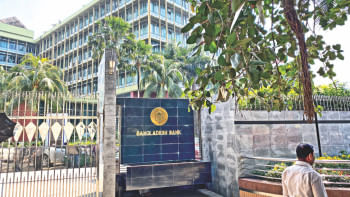An Alluvial Soul

Photos: Kazi Tahsin Agaz Apurbo
Besides presenting Bangladesh's history and archaeological heritages throughout the year, this month Bangladesh National Museum has set to tell the nation's story in a different way. This time, it is not exhibited through the excavated, ruined archaeological evidences; rather the epic saga of this brave nation has been depicted through the creations of one of the best artists of Bangladesh, Kalidas Karmakar.
Kalidas's solo exhibition titled "Alluvial Soul. Soil. Symbol" (January 3 - 24, 2016) strives to interpret the inner philosophy of the nation's struggle against oppression and deprivation; to discover the soul of the people of Bangladesh that is in constant search for liberty.
The versatile representation of different symbols, spontaneous use of colours and sophisticated application of a wide range of media has enlivened the abstract arts so brilliantly, that any visitor, no matter how ignorant about the complex definitions of Cubism and Fauvism s/he is, will be able to delve into the message this great artist has tried to convey.

Besides many recent works, this exhibition has presented some of the best artworks of Kalidas. It includes one of his very first works titled "Communism" that in the beginning of the 70s brought him the reputation of a prodigy of the post-modern art form.
"Experimenting with new materials is a habit of mine," says Kalidas. "One day, I saw some left out parts of a very old car in my father's workshop. The rays of the morning sun fell on those decayed machines in such an angle that its unique beauty suddenly hit my mind. Then, I started to begin my experiment with those rusticated tools."
And the outcome of it is the masterpiece "Communism." The artwork with elaborate use of metallic substances and tools and exquisite paintings on them reveals how human beings have suffered under the mechanical rule of communism that creates a state of artificial equality at the cost of the liberty of human soul.
Another of Kalidas's famed artwork "Devastated" has brilliantly depicted the ruthless destruction and torture that befell upon Bangladesh during the nine-month long liberation war. Twisted and deformed female figures on the back of a serpent and vulture truly portrayed the brutality of the Pakistan army inflicted on the people of this land. A red circle on the top right corner of the painting symbolises the rising of Bangladesh's independent sun at the cost of the bloody sacrifice.

Regarding the versatile usage of symbols, Kalidas says, "If we explore the history of human civilisation, symbols are the integral part of our life and culture."
"In Hinduism we worship the black stone which is a symbol that is a circle, in Islam we circle around the Kaaba which is also a symbol and it is also a circle, then in Christianity we believe in the power of trinity that is a triangle; this is why in my artworks, I have tried to depict the human beliefs through different symbols," he adds.
Besides his amazing abstract artworks, one of the major attractions of his exhibition is a big installation at the centre of the gallery. Using numerous statuettes of different textures, diversified components of rural Bengali culture, Kalidas has visualised the nation's story brilliantly.
Born in Faridpur on January 10, 1946 Kalidas graduated from the Government College of Fine Arts, Kolkata in 1969. Afterwards, he was awarded with numerous rewards, scholarships and research fellowships from difference countries for his scholarly contribution in various disciplines of art. This brilliant artist, now in his seventies, wants to work for the rest of his life to spread the essence of Bangladesh's liberation through his artworks.


 For all latest news, follow The Daily Star's Google News channel.
For all latest news, follow The Daily Star's Google News channel. 



Comments